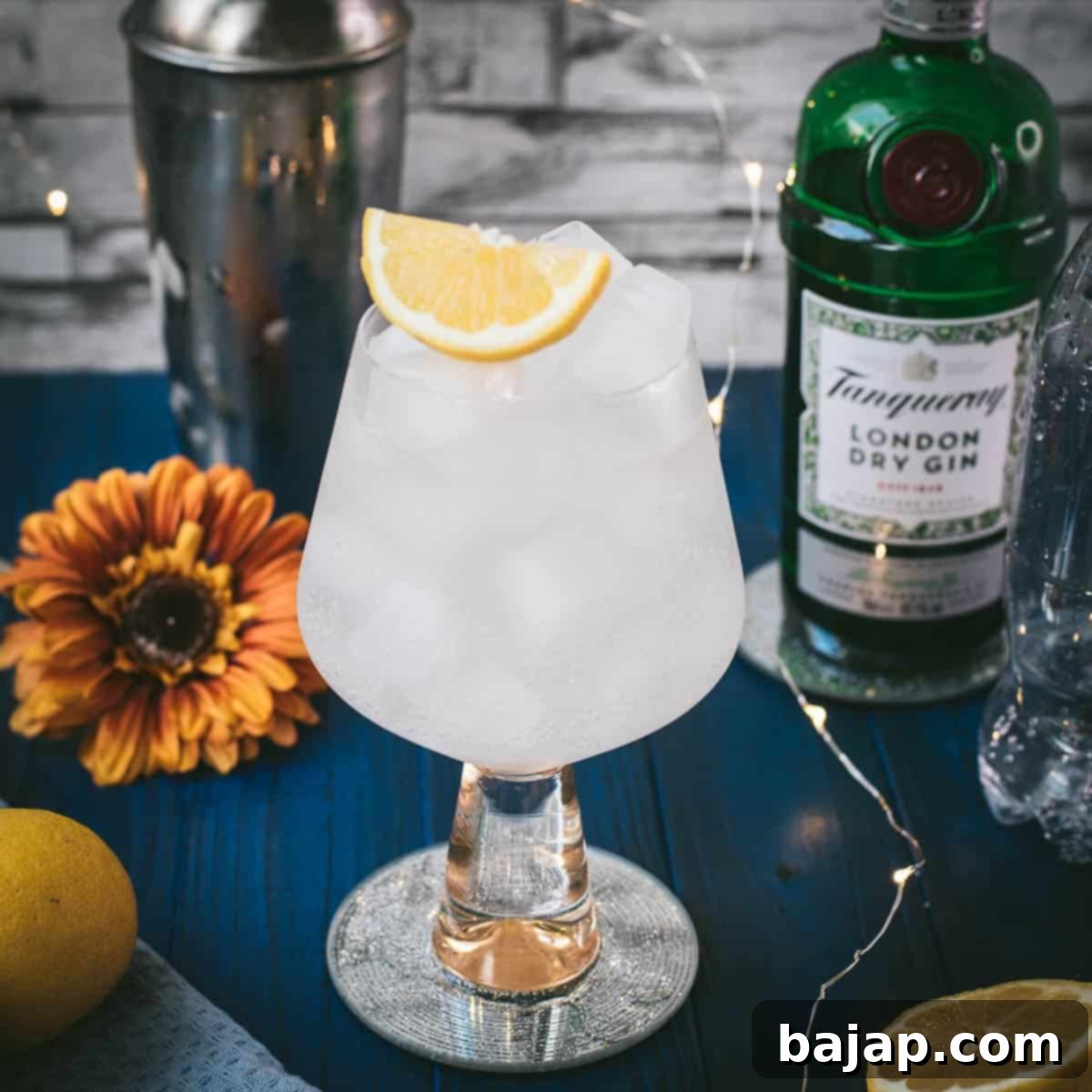Refreshing Lemon Gin and Tonic: Your Ultimate Guide to a Crisp, Citrusy Cocktail
If you’re a fan of citrus and prefer the bright, zesty notes of lemons over limes, then prepare to fall head over heels for this incredible lemon gin and tonic recipe! It’s a wonderfully sweet and crisp concoction that offers a delightful twist on a classic, making it the perfect pairing for a warm summer evening, a casual brunch, or any moment you crave a truly refreshing sip.
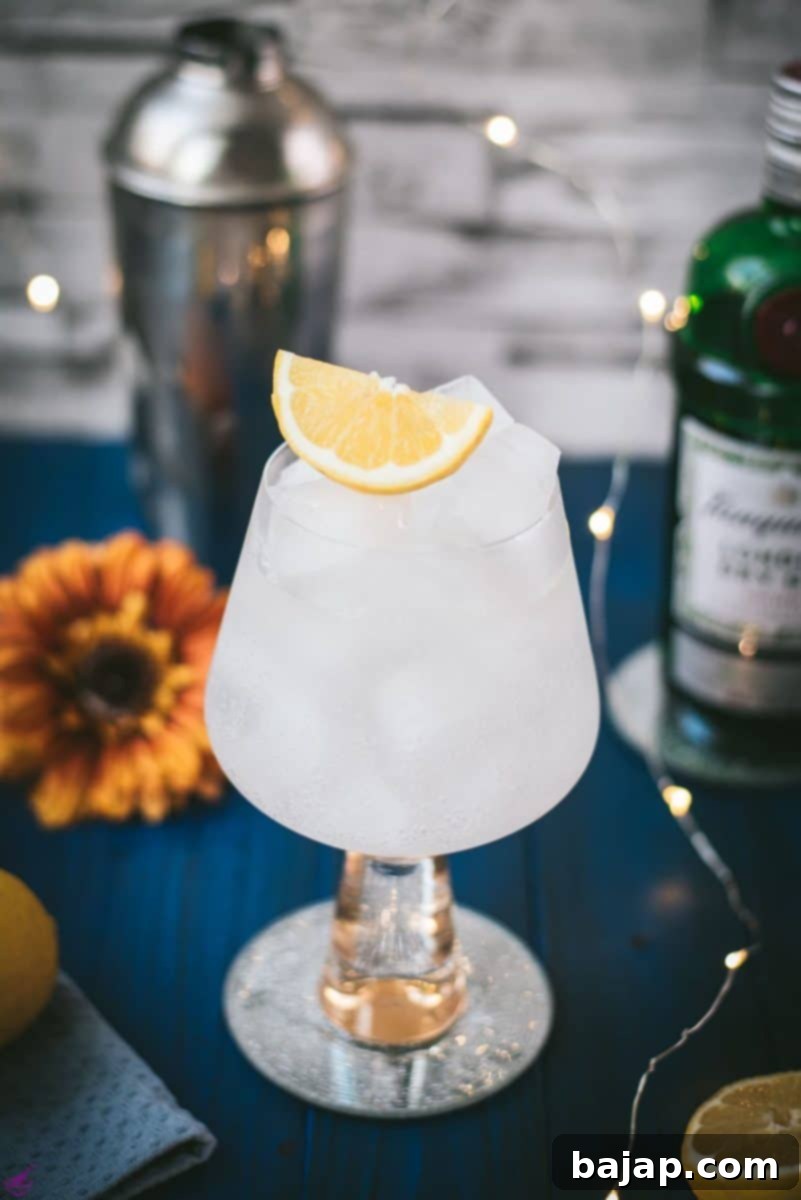
While the traditional gin and tonic with lime is undeniably iconic and beloved for good reason, there’s a truly special place in my heart for the lemon variation. It holds a nostalgic charm for me, as it was the very first cocktail I mastered during my bartending school days. Through countless iterations, I’ve developed a deep appreciation for its inherent simplicity, its elegant flavor profile, and its remarkable versatility. This isn’t just a drink; it’s an experience waiting to be customized.
As someone who adores showering friends and family with warm hospitality, I particularly love how much room this cocktail recipe offers for customization. You can easily tailor it to fit your guests’ individual preferences, or even align it with the theme of a special occasion. The world of gin and tonic is vast, with an incredible array of different gin varieties and tonic waters available, leading to truly countless flavor combinations. From floral to herbaceous, spicy to citrusy, the possibilities are endless when you start experimenting!
Plus, a major bonus is how incredibly quick and easy these lemon gin and tonics are to whip together. This means I can spend less time shaking and stirring behind the bar and more time engaging in lively conversation and enjoying the precious company of my loved ones. It’s the perfect fuss-free, yet sophisticated, drink for any gathering.
Don’t forget to mark your calendars! National Gin and Tonic Day is celebrated on April 9th! What better way to celebrate than with this bright, lemony concoction?
🎥 Watch the Recipe Video
See exactly how to craft this delightful lemon gin and tonic with our step-by-step video guide. Perfect for visual learners!
🥘 Essential Ingredients for Your Lemon Gin and Tonic
Crafting the perfect lemon gin and tonic starts with selecting high-quality ingredients. Each component plays a crucial role in achieving that crisp, balanced, and invigorating flavor. Here’s a closer look at what you’ll need and some tips for choosing the best:
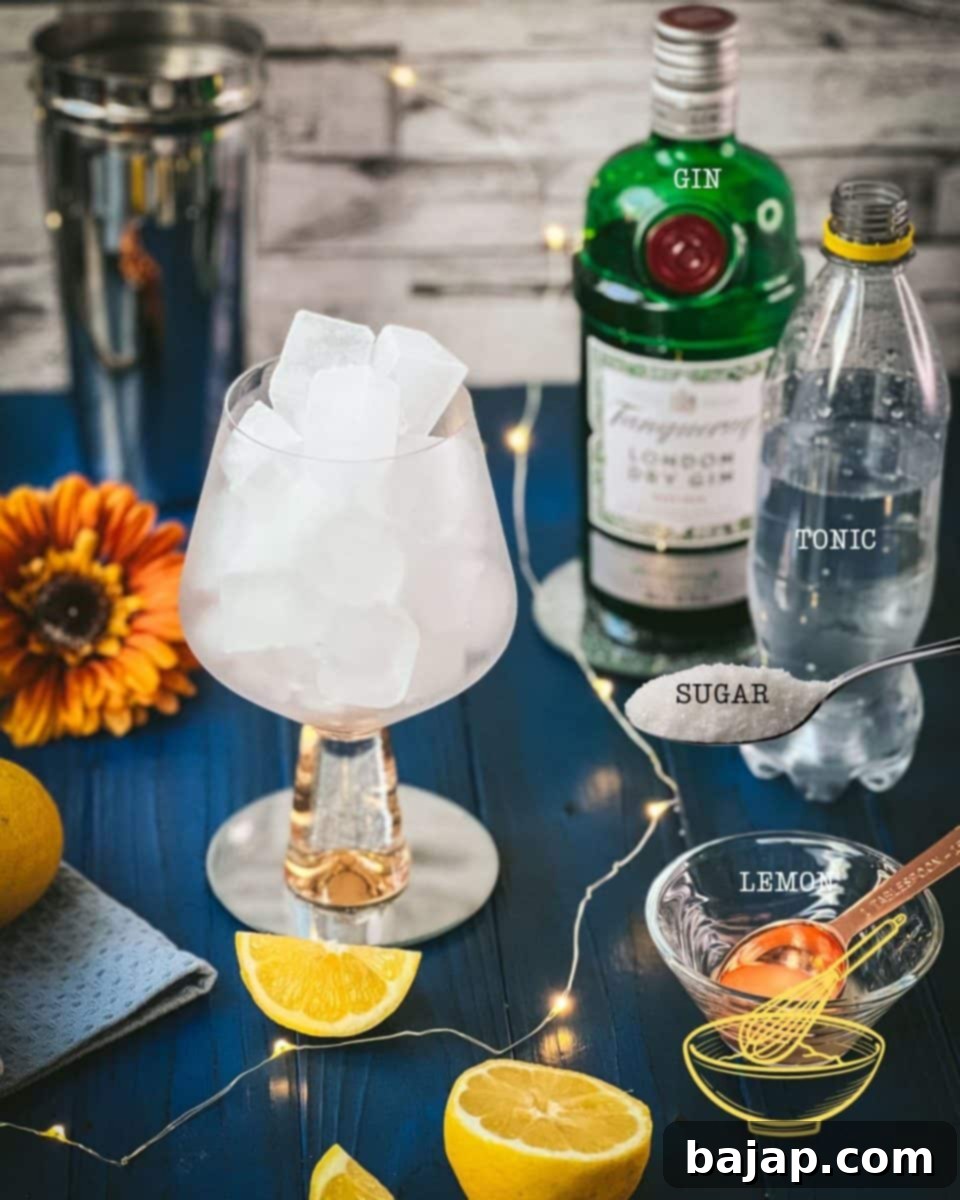
- Ice Cubes: Fill your glass to the brim for optimal chill and minimal dilution. Larger ice cubes are always preferred.
- Gin of Your Choice: The soul of your cocktail. While a classic London Dry works beautifully, feel free to explore other styles like a more floral gin or one with prominent citrus notes to complement the lemon. (Find out more about choosing your gin here).
- Fresh Lemon Juice: This is key! Freshly squeezed lemon juice provides a vibrant, natural tartness that bottled juice simply can’t replicate.
- Granulated Sugar: A touch of sweetness helps balance the lemon’s acidity and enhances the overall crispness.
- Tonic Water: The other half of the classic duo. The type of tonic you choose can significantly impact your drink’s flavor. High-quality tonic with a good balance of bitterness and sweetness is recommended.
- Lemon and Drinking Straw for Garnish: A lemon wedge or twist adds an aromatic flourish and visual appeal, while a reusable straw is a sustainable choice.
For precise measurements and a printable recipe, see the full recipe card below.
🍹 Step-by-Step Guide to Crafting Your Lemon Gin and Tonic
This cocktail is remarkably simple to put together, making it perfect for both novice and experienced home bartenders. Just follow these easy steps for a perfectly balanced and refreshing drink:
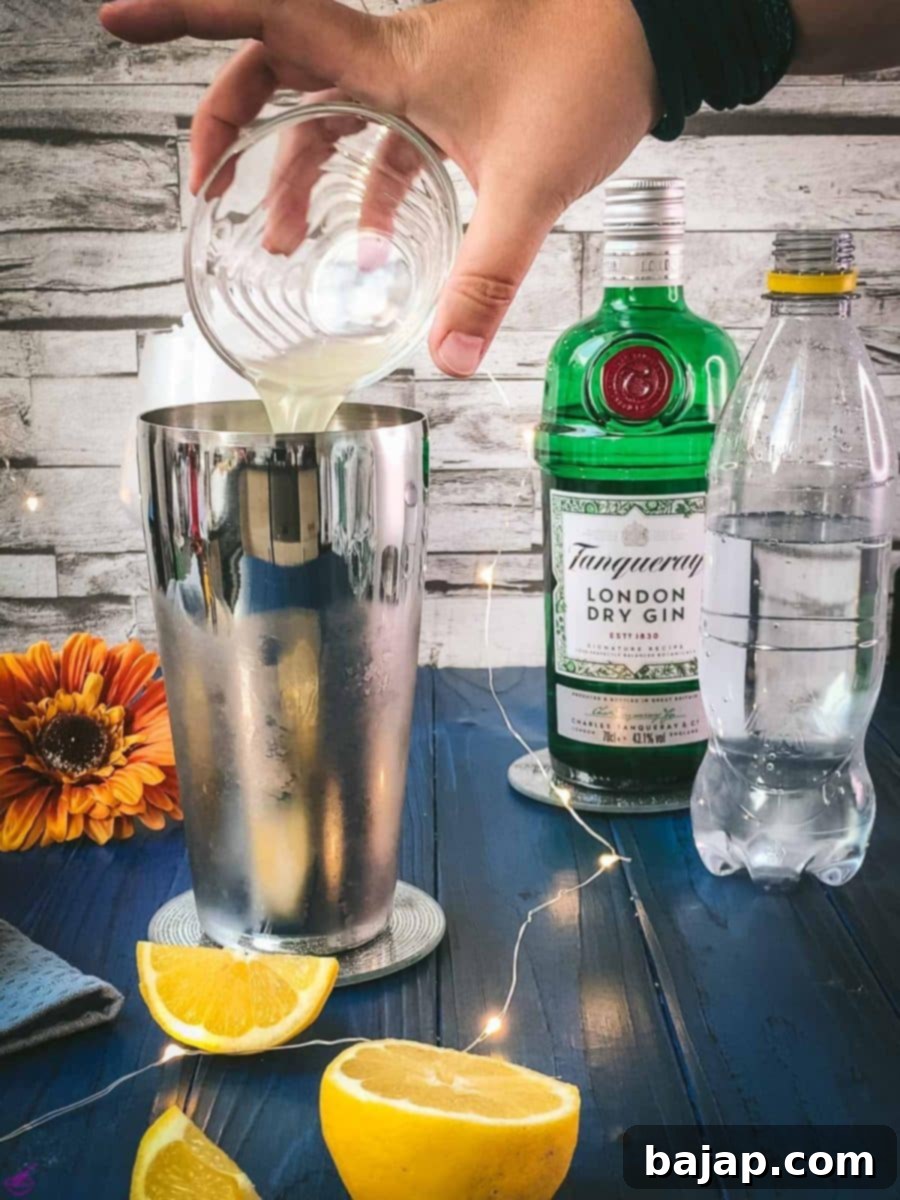
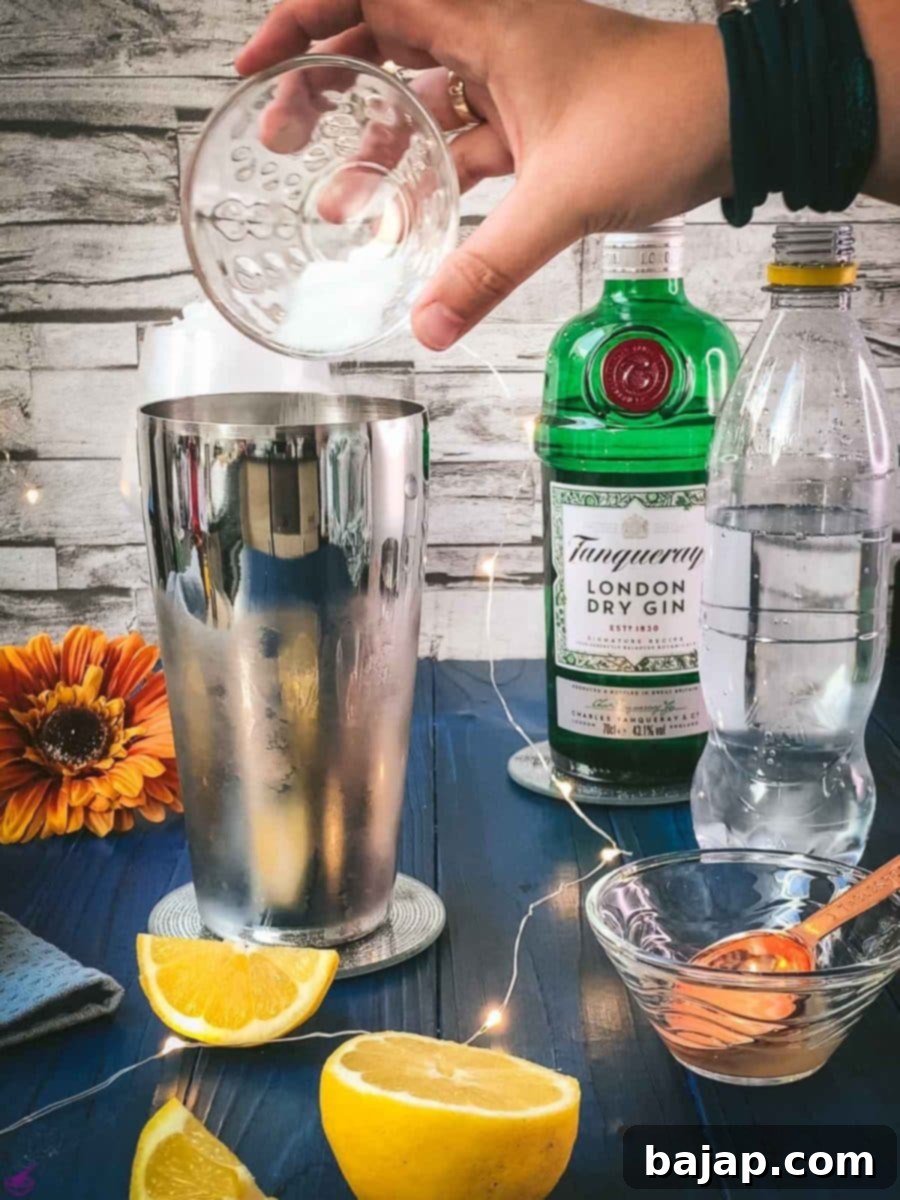
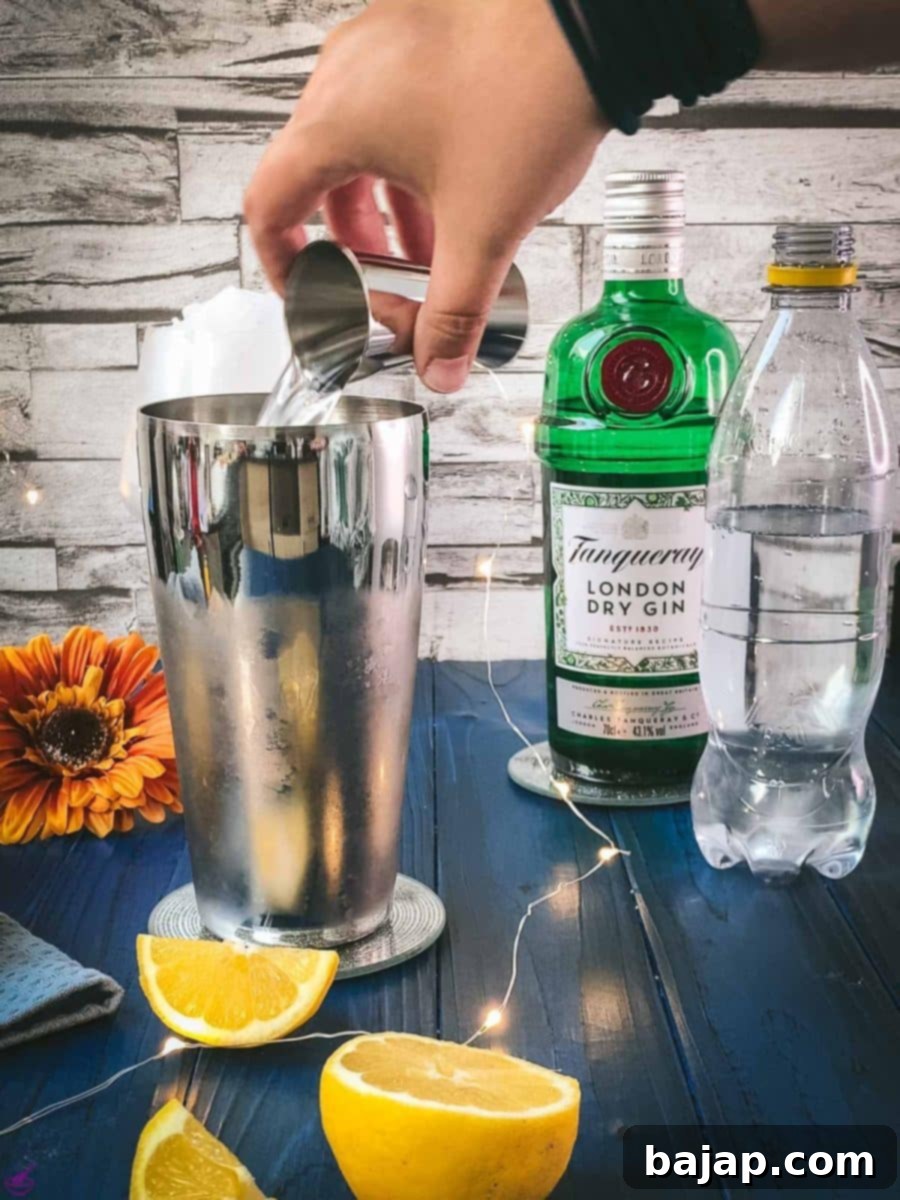
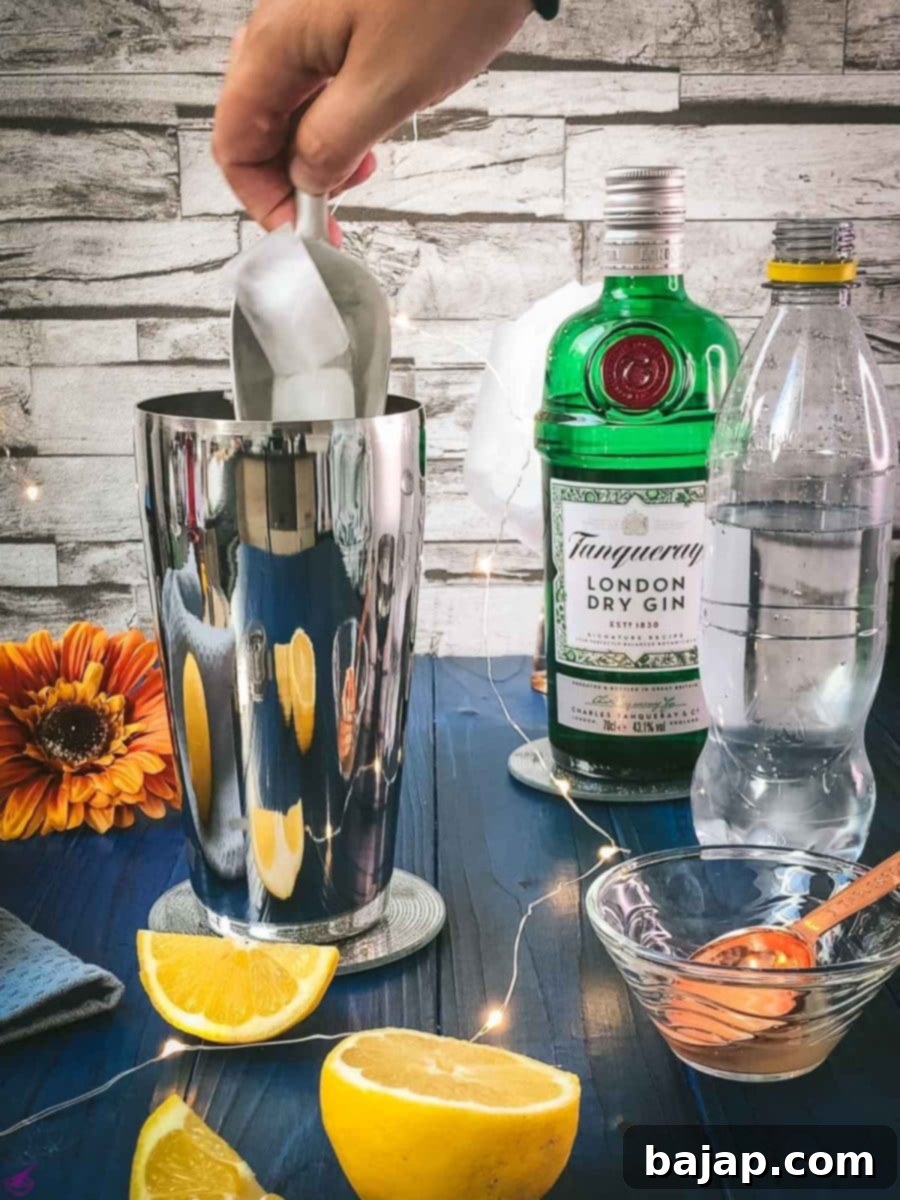
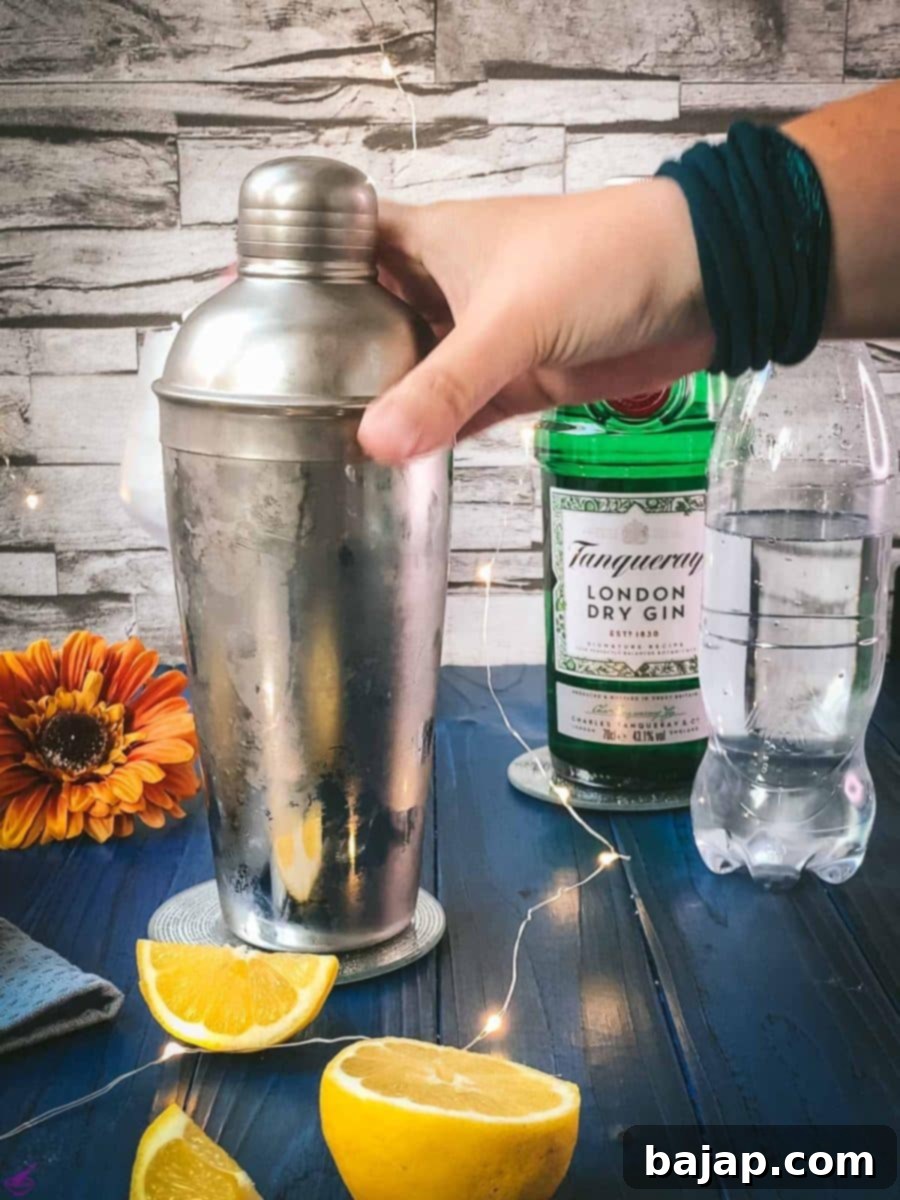
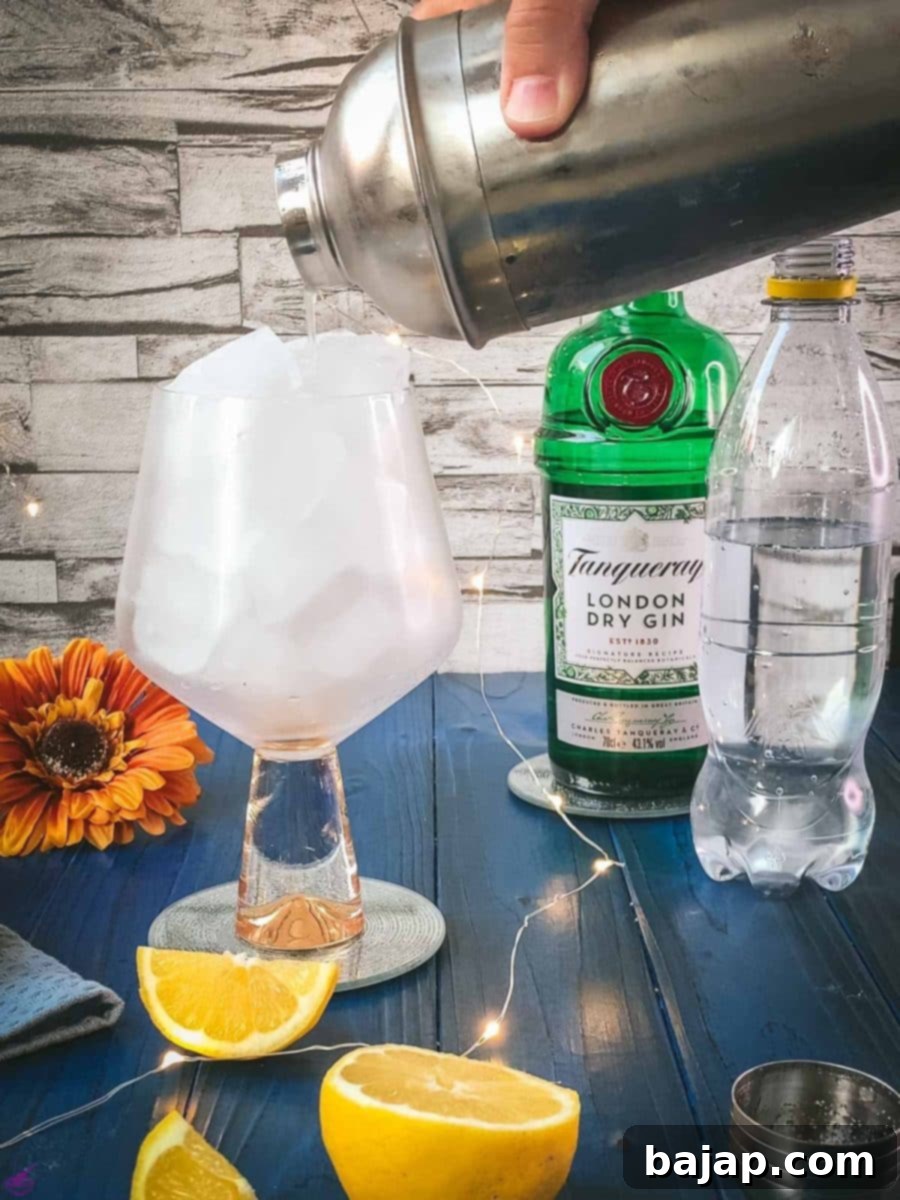
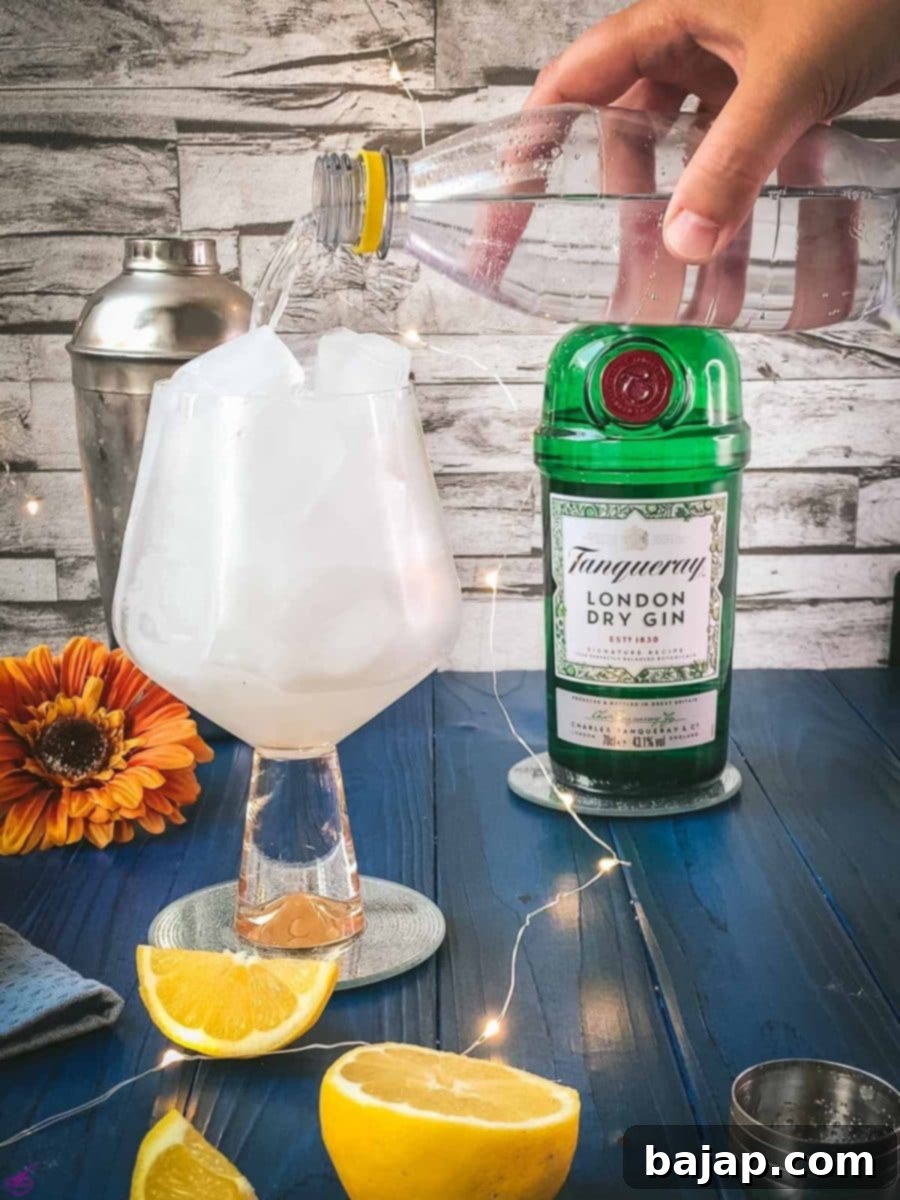
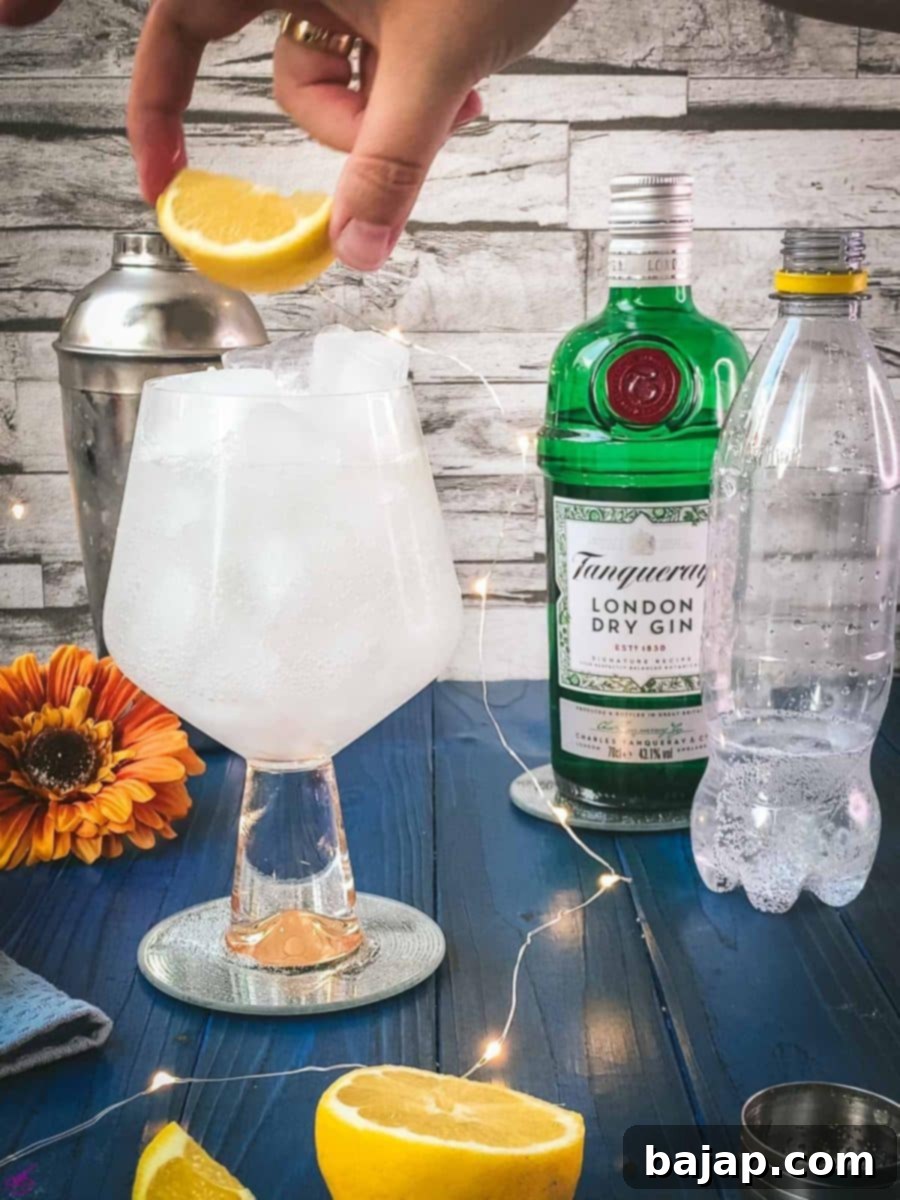
🔪 Detailed Instructions for a Perfect Lemon G&T
As far as sophisticated yet easy-to-make cocktails go, this one truly takes the cake! It’s straightforward and comes together in a flash, ensuring you’re sipping on perfection in no time.
- Prepare Your Lemon Base: Begin by taking half of your fresh lemon and squeezing out its juice. You’ll need about 1 tablespoon of this vibrant lemon juice. Combine this with 1 teaspoon of granulated sugar and 1 ½ oz of your preferred gin in a cocktail shaker. The sugar will dissolve better when shaken with the liquid ingredients, and the base will be thoroughly chilled.
- Add Ice to Shaker: Now, fill your cocktail shaker with a generous amount of ice cubes. The more ice, the colder your drink will get, and the less dilution you’ll experience during shaking.
- Shake It Up: Secure the lid on your shaker and give it a good, vigorous shake. You want to shake until the outside of the shaker feels thoroughly chilled and frosty to the touch, which usually takes about 15-20 seconds. (Fun tip: I personally like to shake mine while singing the chorus of “Conga” by Gloria Estefan and the Miami Sound Machine – the rhythm and timing work out perfectly!).
- Prepare Your Glass: While your gin and lemon base is chilling, fill your chosen highball or balloon glass to the brim with fresh ice. Pre-chilling your glass beforehand (see “Top Tip” below) will also help keep your drink colder for longer.
- Pour and Strain: Once your mix is perfectly chilled, it’s time to pour. Open your shaker and carefully strain the gin, lemon, and sugar mixture over the ice in your prepared highball or balloon glass. If you’re using a Boston shaker, a julep strainer is ideal for this step to ensure no ice shards or pulp make it into your final drink.
- Top with Tonic: Gently fill the remaining space in your glass with tonic water. A typical highball glass holds between 1 cup (240ml) to 1 ½ cups (350ml), so there will be ample room for the tonic after you’ve poured the gin base. Pouring gently helps preserve the tonic’s effervescence.
- Garnish and Serve: Finally, all that’s left to do is add your garnishes! A fresh lemon wedge or a delicate lemon twist adds both a beautiful visual touch and an aromatic burst as you sip. Pair it with a fun, reusable drinking straw, and your refreshing lemon gin and tonic is ready to be savored!
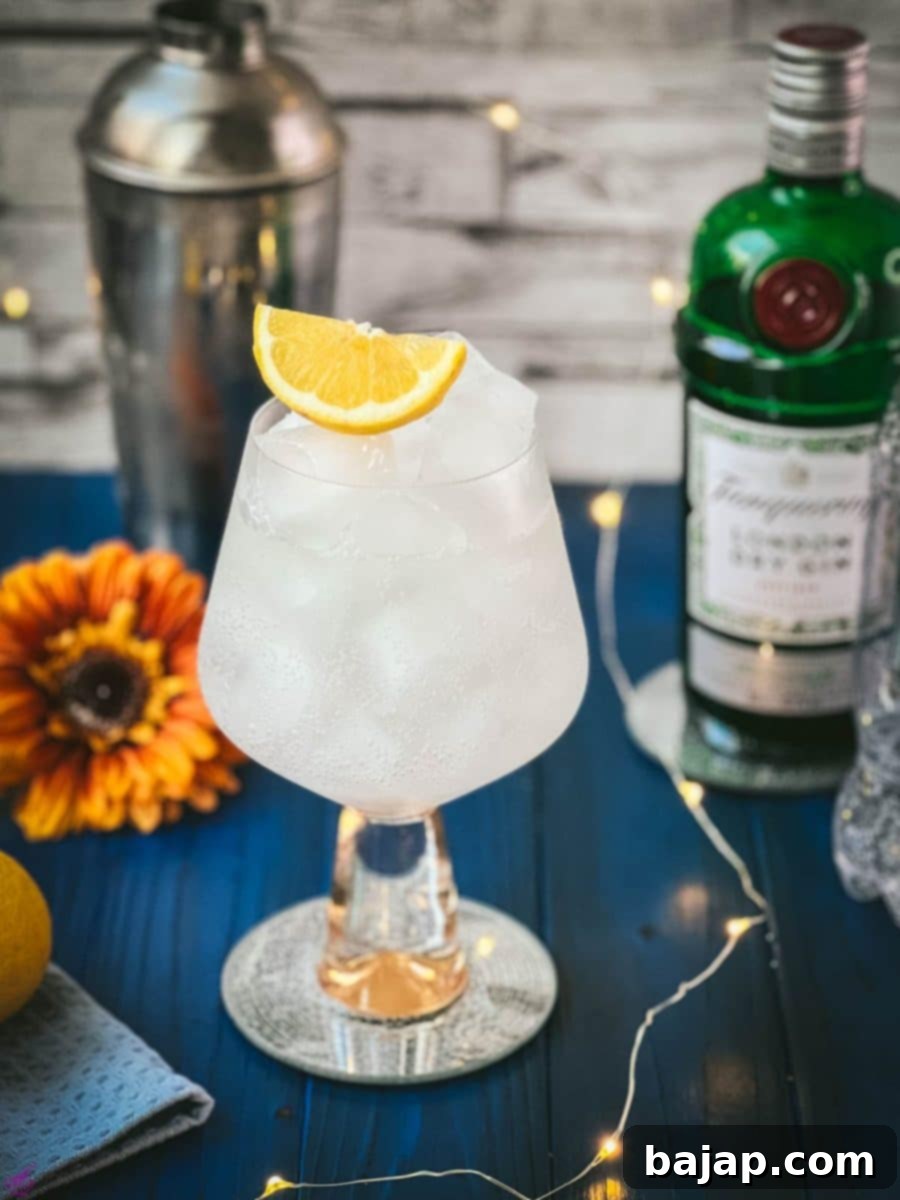
🍋 Delicious Variations to Try
The beauty of a classic cocktail like the gin and tonic lies in its adaptability. While this lemon gin and tonic is fantastic as is, don’t hesitate to experiment and make it your own!
- Adjusting Sweetness: If you find the fresh lemon a bit too tart, or simply prefer a sweeter cocktail, an extra dash (or half teaspoon) of granulated sugar or a splash of simple syrup can easily mellow the acidity and enhance the drink’s sweetness. You could also try a flavored simple syrup, like a lemon-ginger or a basil simple syrup, for an added layer of complexity.
- Exploring Gin Varieties: The classic gin and tonic offers endless varieties simply because of the vast world of gin itself! Each gin boasts its own unique botanical profile, from juniper-forward London Dry styles to more floral, herbaceous, or even savory gins. Consider how different gin types will interact with the lemon. A citrus-forward gin will amplify the lemon notes, while a more botanical gin might create an intriguing contrast. For an in-depth dive into the world of gin, be sure to check out our comprehensive Gin & Tonic Guide!
- Tonic Water Pairings: Just like gin, tonic water comes in many forms. Experiment with different brands and flavors. A classic Indian tonic will provide a traditional bitter balance, while a Mediterranean tonic might add a softer, more herbal note. Elderflower tonic can introduce a delicate floral sweetness, or a light tonic if you’re watching your sugar intake.
- Other Citrus Zest/Juice: While we’re celebrating lemon here, a gin and tonic can be wonderfully adapted with other citrus fruits. Try a splash of grapefruit juice and a grapefruit peel for garnish, or even a hint of orange for a sweeter, warmer profile.
- Herbal Infusions: A sprig of fresh rosemary, thyme, or basil can add a sophisticated aromatic dimension. Lightly muddle a few leaves in the shaker with the gin and lemon, or simply use them as a fragrant garnish.
🍽 Essential Equipment for Your Bar
Having the right tools makes all the difference in crafting consistently delicious cocktails. Here’s what you’ll need for your lemon gin and tonic:
- Jigger: An essential tool for accurately measuring your spirits and mixers, ensuring a balanced cocktail every time.
- Cocktail Shaker: Used to rapidly chill and blend your gin, lemon juice, and sugar. A good shake ensures all ingredients are well incorporated and properly diluted.
- Lemon Squeezer: Makes quick work of extracting fresh lemon juice, ensuring you get maximum yield with minimal effort and no seeds.
- Julep Strainer (If you are using a Boston Shaker): Necessary for cleanly separating the chilled liquid from the ice in your shaker.
- Highball Glass or Balloon Glass (Chilled): The ideal serving vessel, allowing ample space for ice and tonic, and showcasing the drink’s vibrant color.
🌡 Storage & Best Practices
For several crucial reasons, a lemon gin and tonic is a cocktail that truly shines when enjoyed immediately after preparation. Its fresh, crisp taste and effervescent qualities are fleeting, and here’s why prompt consumption is key:
- Tonic Water Fizz: The primary reason is that tonic water, like all carbonated beverages, will eventually go flat. Once mixed, the carbonation begins to dissipate, taking away the invigorating sparkle that gin and tonics are famously known for.
- Ice Dilution: As ice melts, it dilutes your drink. While a certain amount of dilution is desirable to mellow the flavors, too much will water down your beautiful cocktail, diminishing its intensity and crispness.
- Freshness of Lemon: Fresh lemon juice provides a bright, vibrant aroma and flavor that starts to degrade over time once exposed to air and mixed with alcohol.
Therefore, it’s always best to mix and serve your lemon gin and tonic fresh. If you’re hosting a party, you can pre-measure your gin and lemon juice mixture, and even add the sugar, then chill this base. However, always add the tonic water and ice just before serving each individual drink to ensure maximum freshness and fizz.
💭 Top Tip: The Secret to a Perfectly Chilled Cocktail
When preparing your gin and tonic cocktails, paying attention to how you handle your glassware can make a significant difference. It’s important that you hold your highball glasses from the bottom or stem and avoid touching the rim or body of the glass with your warm hands. By doing this, you help keep your chilled glass nice and cool – which, in turn, keeps your cocktail colder for longer and makes it taste that much better!
Are you already wondering, “How do I chill a cocktail glass properly?” The most efficient and effective way to achieve a perfectly chilled glass is to place them in the freezer beforehand. I usually like to give them at least a half hour to get sufficiently cold. However, if you’re like me and often plan to have friends and family over for backyard grilling and dinner parties this summer, you could even throw your glasses in the freezer the night before! A cold glass means slower ice melt and a more enjoyable, undiluted drink.
Finally, to protect our environment and embrace sustainable practices, one final tip I highly encourage is to avoid using disposable straws whenever possible. Instead, opt to use either stylish metal or paper straws, or simply forgo them altogether. Enjoying this refreshing lemon gin and tonic directly from the glass is a perfectly delightful experience!
🙋🏻 Frequently Asked Questions about Lemon Gin and Tonics
This truly comes down to personal preference, as both lemon and lime offer distinct flavor profiles that complement gin and tonic beautifully. Personally, I have a strong preference for a lemon gin and tonic because of its bright, slightly sweeter, and less sharp citrus notes compared to lime. However, many people consider the classic lime gin and tonic to be sacred! If you’re unsure which you like better, I highly recommend crafting both at home and hosting a fun tasting party to decide your favorite. Each offers a unique, refreshing experience!
The iconic addition of lime to gin and tonic has a fascinating historical origin. It was first added to quinine (a key ingredient in tonic water, used as a prophylactic against malaria) in the 19th Century, primarily to help make the extremely bitter taste of quinine more palatable for British soldiers and colonists in tropical regions. Somewhere along the way, they started adding gin to the mix for its medicinal and social qualities, and the cocktail quickly became wildly popular! The lime stuck around for its refreshing flavor and aromatic contribution. If you want to know more about the captivating history behind gin and tonic, check out our in-depth gin and tonic guide!
Quinine is an alkaloid historically derived from the bark of the cinchona tree, originally used as a prophylactic and treatment for malaria. Its intensely bitter taste led to it being mixed into carbonated beverages – eventually becoming what we know today as tonic water. In fact, all commercial tonic waters contain some amount of quinine. The lime (or lemon, in this case!) was first added to tonic to help make this bitter taste more palatable, balancing it with a fresh, acidic note. When combined with gin, a spirit distilled with botanicals (especially juniper), it creates the classic gin and tonic, a harmonious blend of bitter, sweet, and aromatic flavors.
Ideally, a gin and tonic is best enjoyed with a refreshing twist and in good company! Beyond this delightful lemon gin and tonic recipe, there are many fantastic variations to explore. For instance, this cucumber gin and tonic recipe is also incredibly tasty and offers a cool, crisp alternative. Experiment with different garnishes, types of gin, and tonic waters to find your perfect combination. The key is to serve it ice-cold, in a chilled glass, allowing the flavors to truly sing.
OTHER RECIPES FOR YOU TO TRY
Looking for more refreshing drinks and cocktail ideas? Explore these other fantastic recipes from our collection:
- Strawberry Spritz Cocktail: A light and bubbly choice for fruit lovers.
- Refreshing Lavender Daiquiri: An elegant and aromatic twist on a classic.
- Refreshing Cucumber Gin and Tonic: Another crisp and cool variation of the G&T.
- Homemade Vodka Sidecar: A sophisticated and smooth cocktail for vodka enthusiasts.
- Lovely Lavender Spritz Cocktail: Floral and fragrant, perfect for a relaxing evening.
- Vanilla Vodka and Tonic: A creamy and unique take on the classic tonic mix.
If you make this delightful lemon gin and tonic recipe, I would absolutely love to hear how you liked it! Please consider giving it a ★★★★★ star rating and leaving a comment below – it would be awesome to get your feedback and know what you thought. You can also sign up for our Newsletter to receive weekly delicious homemade recipes directly in your inbox. And don’t forget to follow me on Pinterest or Instagram and share your creation with me! Just tag me @combinegoodflavors and use the hashtag #combinegoodflavors, so I don’t miss it. Happy mixing!
📖 Recipe Card

Refreshing Lemon Gin and Tonic
Nora
Save RecipeSaved!
Pin Recipe
Equipment
-
Jigger
-
Cocktail shaker
-
Lemon squeezer
-
Julep strainer if you are using a Boston shaker
-
Highball Glass or balloon glass
Ingredients
- Cubed Ice
- 1 ½ oz Your favorite gin
- 1 tablespoon Lemon juice
- 1 teaspoon Granulated sugar
- 1 cup Tonic to fill up the glass
- Lemon wedge and drinking straw for garnish
Instructions
-
Squeeze half a lemon and add 1 tablespoon Lemon juice, 1 teaspoon Granulated sugar, and 1 ½ oz Your favorite gin to your shaker filled with ice cubes.1 ½ oz Your favorite gin, 1 tablespoon Lemon juice, 1 teaspoon Granulated sugar
-
Close the shaker and shake well.
-
Fill the glass with Cubed IceCubed Ice
-
Then pour the mix directly into the cocktail glass filled with ice cubes. If using a Boston shaker, strain the mix through a julep strainer.
-
Fill up with 1 cup Tonic (one high ball glass holds 240 ml (1 cup) to 350 ml(1 ½ cups)).1 cup Tonic
-
Lemon wedge and drinking straw for garnishLemon wedge and drinking straw for garnish
Nutrition values are estimates only, using online calculators. Please verify using your own data.

🤎 You might also like
- Vanilla Vodka and Tonic
- The Complete Guide to Gin & Tonic
- Refreshing Cucumber Gin and Tonic
- How do you make a Frozen Strawberry Daiquiri
⛑️ Food Safety Guidelines
While cocktails are generally safe, it’s always good to be mindful of basic food and drink safety practices, especially when preparing drinks for others. Here are some general guidelines:
- Cleanliness is Key: Always ensure your hands, utensils, and work surfaces are clean before preparing any food or drink.
- Fresh Ingredients: Use fresh, high-quality ingredients, especially for citrus juices, to ensure the best flavor and safety.
- Proper Storage: Store all ingredients according to their specific requirements (e.g., gin and tonic in a cool, dark place; lemons refrigerated).
- Handle Glassware with Care: Be mindful when handling glass, especially if chilled, to avoid breakage.
- Avoid Cross-Contamination: While not directly applicable to this non-meat recipe, always practice good kitchen hygiene by not using the same utensils or cutting boards for different food types without washing them thoroughly.
- Don’t Leave Drinks Out: Cocktails with fresh ingredients and ice are best consumed immediately. Leaving them at room temperature for extended periods can affect flavor and, in some cases, safety.
- Responsible Consumption: Always drink alcohol responsibly.
- Keep Out of Reach of Children: Ensure all alcoholic beverages are stored safely away from children.
For further information on general safe food and drink handling practices, you can check resources like Safe Food Handling – FDA.
